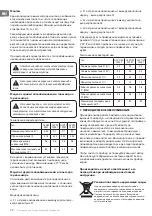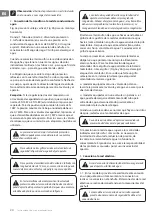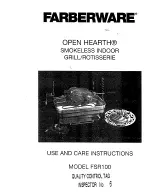
Instructions for use and maintenance
9
EN
English
Dear Clients,
The TESY team would like to congratulate you on your new
purchase. We hope that your new appliance shall bring
more comfort to your home.
This technical description and instructions manual was
prepared in order to acquaint you with the product
and the conditions of proper installation and use. These
instructions were also intended for use by qualified
technicians, who shall perform the initial installation, or
disassembly and repairs in the event of a breakdown.
The observance of the instructions contained herein is
in the interest of the buyer and represents one of the
warranty conditions, outlined in the warranty card.
Please consider that following the current instructions
will primarily be of interest to the consumer, but along
with this, it is also one of the warranty conditions, pointed
out in the warranty card, so that the consumer can
benefit from the free warranty services. The producer is
not responsible for damages in the appliance that have
appeared as a result of operation and/or installation not
corresponding to the instructions here.
The electric water heater complies with the requirements
of EN 60335-1, EN 60335-2-21.
I.
INTENDED USE
The appliance is intended to supply hot water to
household sites equipped with a piping system working at
pressure below 6 bar (0,6 Mpa).
It is designed to operate only in closed and heated premises
where the temperature is not lower than 4°C and it is not
designed to operate in a continuous protracted regime.
The appliance is designed to operate in regions where the
water hardness is not more than 10°dH. In case that it is
installed in a region where the water is harder it is possible
that limestone precipitation accumulate very fast. This
can cause a specific noise during heating, as well as fast
damaging of the electrical part. For regions with harder
water yearly cleaning of the limestone precipitation in the
appliance is recommended, as well as usage of not more
than 2 kW of heating power.
II.
TECHNICAL PARAMETERS
1.
Nominal volume V, liters - see the appliance’s rating
plate
2.
Nominal voltage - see the appliance’s rating plate
3.
Nominal power consumption - see the appliance’s
rating plate
4.
Nominal pressure - see the appliance’s rating plate
This is not the water mains pressure. This is the pressure
that is announced for the appliance and refers to the
requirements of the safety standards.
5.
Water heater type - closed type accumulating water
heater, with thermal insulation
6.
Inner coating - for models: GC-glass-ceramics
For models without heat exchanger (coil)
7.
Daily energy consumption – see Annex I
8.
Rated load profile - see Annex I
9.
Quantity of mixed water at 40°C V40 litres - see Annex I
10.
Maximum temperature of the thermostat - see Annex I
11.
Default temperature settings - see Annex I
12.
Energy efficiency during water heating - see Annex I
For models with heat exchanger (coil)
13.
Storage volume in litres - see Annex II
14.
Standing loss - see Annex II
III.
IMPORTANT RULES
•
The water heater must only be mounted in premises
with normal fire resistance.
•
Do not switch on the water heater unless you
established it was filled with water.
•
Qualified P&P specialists and Electricians must only
perform the connecting of the water heater to the water
and electric mains. A qualified technician is a person who
has the competence according the regulations of the
country in question.
•
Upon connecting the water heater to the electric mains
care must be taken to connect the safety lead.
•
If the probability exists for the premise’s temperature to
fall below 0°C, the water heater must be drained (observe
the procedure outlined in section V, subsection 2 ‘’Water
heater’s piping connection”).
•
During operation – regime of heating the water – water
drops through the drainage opening of the protection
valve are usual.
•
The protection valve should be left open to the
atmosphere. Measures should be taken to lead and collect
the leakages in order to prevent damages, ensuring that
this is in conformation with the requirements described in
p. 2 in paragraph V.
•
The valve and the elements linked to it must be
protected from freezing.
•
During the heating the appliance could produce a
hissing noise (the boiling water). This is common and
does not indicate any damage. The noise gets higher
with the time and the reason for this is the accumulation
of limestone. To remove the noise the appliance must
be cleaned from limestone. This type of cleaning is not
covered by the warranty.
Содержание GCV6S
Страница 183: ...1 b DIMENSIONS mm 5 Type GCHS 8047 GCHS 10047 GCHS 12047 A 842 982 1147 B 407 552 702 C 360 480 480 D 470 470 470 1 ...
Страница 185: ......
Страница 186: ...3 ...
Страница 187: ...4 ...










































